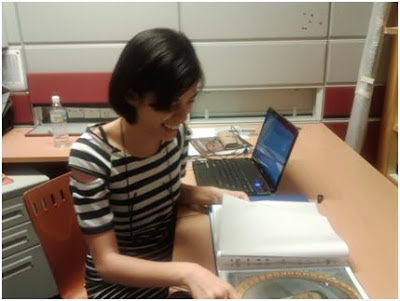Diary of an NUS Museum Intern: Cindy Lin
Note: Diary of an NUS Museum Intern is a series of blog posts written by our interns about their experiences during the course of their internships. Besides working hard and fast in their cubicles, our interns have travelled to Bandung and Malacca, organised symposiums, waded through tons of historical research and pitched in during exhibition installations. If you would like to become our next intern, visit our internship page for more information!
For the summer of 2013, we have a total of 9 interns at the museum! Each intern will be taking it in turns to contribute an article to the Museum Blog every other week. For daily (or even hourly!) sneak peeks at what they are doing, visit the Museum's Twitter account (@nusmuseum).
For the summer of 2013, we have a total of 9 interns at the museum! Each intern will be taking it in turns to contribute an article to the Museum Blog every other week. For daily (or even hourly!) sneak peeks at what they are doing, visit the Museum's Twitter account (@nusmuseum).
-
Cindy Lin is a second-year Southeast Asian Studies major from the University Scholars Programme and the Faculty of Arts and Social Sciences. Cindy is a South & Southeast Asian Collections Curatorial Intern and is currently researching for an upcoming exhibition about batiks.
Prior to my internship, I was told
that I may deal with art which claim to reinstate the shadows of batik-makers
in Yogyakarta. As a student heavily
invested in the notions of agency, labour and capitalism, I was reflexively
thrilled by the idea of being able to deal with art that intertwines deeply
with labour politics and subaltern voices. What I did not expect as a
curatorial intern in NUS Museum was how much my perspectives have broadened within
a month.
Claire Bishop in “Social Turn:
Collaboration and its Discontents” called for relational artists to remain
relevant to aesthetics and not blunt art criticism in their politicized agendas
and dialogical focus when creating art. When conceptualizing “The Wax on our
Fingers”, a project initiated by two thoroughly inspiring and effortful artists
(Mintio and Kabul), I encountered the hurdles of conceptualizing unfamiliar
terrain. Trawling the internet for relational art where I could possibly draw
similarities from, I learned a lot regarding collaborative art. The curator, Ms
Foo Su Ling, also patiently guided me along as my supervisor and mentor; consistently reviewing my work and providing thought-provoking suggestions.
Although “The Wax on our Fingers” was
a variant from the conventional characteristics of relational art, my process
towards conceptualizing an art work and how it is situated within a spectrum of
possibilities has inevitably enhanced my learning experience. Resultantly, I
saw the potential of meanings this series of unique portraits meticulously
superimposed on traditional batik possesses. To derive a single
meaning from an art piece is simply too reductive.
Besides dealing with theoretical
papers on participatory and relational art, I met many agents and spaces within
the art sphere. I spoke to artists,
Mintio and Kabul in an insightful meeting with Su Ling where we discussed the
various factors involved in creating an exhibition. Insurance rights, outreach
programmes and other obscure factors an art enthusiast may have little
knowledge of, unveil their significance in museology and art direction. My
initial cynicism regarding cultural preservation and the term “heritage” slowly
disintegrated as I learn to appreciate the multiplicity of interpretations art
viewers or history enthusiasts will leave such spaces with (without
compromising such spaces and turning them in to historical spectacles). As Su
Ling mentioned before, it is best to curate appropriately and be relevant
to the audience. To be flexible, relevant and relative to your viewers appear
to be a valuable rule I’ve learnt.
Even conservation to preserve (and
with careful intent I shall use this word) remained relevant in our perpetual
surge to consume newer things excessively today. I learnt that NUS Baba House is
beyond the essentializing realms of cultural preservation. It is a space where
Peranakan culture has and is constructing and (re)constructing itself
contextually. Although the Baba House appears to be the pinnacle of Peranakan
culture frozen in early 20th century, I learnt that conserving it in
such a manner allows us to constantly question our cultural identities throughout
history. We will see change and that is pertinent in understanding how
historically, cultural identity is a flux and never static.
The romantic tinge of an occupation
at the museum happens every so often when your job involves defining yourself
against Art with a capital A. However, we fail to realize how institutional art,
especially museums tied to the University tries to decenter away from
appreciating art with pretentiousness and prejudices. Ernst Gombrich in his
widely acclaimed work, “The Story of Art” suggests that “Art with a capital A
has come to be something of a bogey and a fetish.” I have also increasingly
understood that artists’ well-intended art should not overwhelm a curator or
critic’s aesthetic judgment when appreciating an art piece. As a curatorial intern
in NUS Museum, what I am most grateful for is my letting go of a puerile and
narrow appreciation for Art and my
growing openness to the arts. This curatorial internship has also provided
avenues for creative input and a space for me to grow both in maturity and
innovativeness.
1. Bishop, Claire. The Social Turn:
Collaboration and its Discontents. Accessed June 3, 2013.
http://danm.ucsc.edu/media/events/2009/collaboration/readings/bishop_collaboration.pdf
2. Gombrich, Ernst Hands Josef. The
Story of Art. (United Kingdom: Phaidon Press,
Ltd., 1995) 7-15.





Comments
Post a Comment